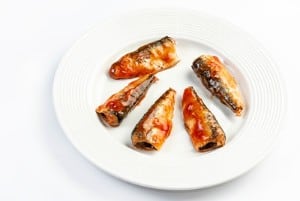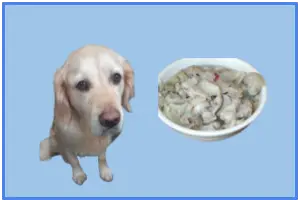
Fish is good for your health, everybody knows that, and many pet owners wonder if it could also benefit their dog.
While feeding your dog salmon every day might prove a bit too expensive, pilchards are a more convenient option and they’re readily available.
Can you give your dog pilchards in tomato sauce, for instance? The answer is not that simple.
The pilchards themselves are packed with essential nutrients, but you need to be mindful of their high fat content. Also, the sauce they come in isn’t toxic in any way, but it isn’t quite healthy either.
To put it plainly, pilchards in tomato sauce are great as an occasional snack and we’ll explain why this type of food should become a staple of your dog’s diet.
Pilchards vs Sardines. What is the difference?
The term pilchards might be confusing for many who wonder if it’s the same thing as sardines. Technically, yes they’re the same type of fish and they both belong to the herring family.
In the UK, the term pilchard is used to refer to small sardines, usually caught in the Northeastern parts of the Atlantic, as well as in the Mediterranean and the Black Sea.
The same fish caught in any other part of the world is simply referred to as sardines.
Bottom line, pilchards and sardines are the same thing and they have the same nutritional values.
How nutritious are pilchards for dogs?
The main benefit of feeding pilchards to your dog is that they are packed with omega-3 fatty acids, as well as vitamins and minerals.
Pilchards have 382 mg of calcium per 100 g of fish, and 2.92 mg of iron.
The good part about feeding your dog pilchards is that they do not contain any carbs, if you exclude the sauce that is.
Pilchards are mostly protein and fats. You might want to avoid too many fats in your dog’s diet, but the high protein content is good for your furry friend as it helps build muscle and keeps him in shape.
Depending on the brand, an average can of pilchards in tomato sauce (155 g) provides between 200 and 250 calories.
This is something you need to keep in mind as this type of food is highly-calorific and might cause problems if your dog is prone to obesity.
The omega-3 fatty acids provide a wide range of health benefits, such as:
- Strengthen the dog’s immune system and help prevent cancer.
- Reduce inflammation which is great for senior dogs suffering from arthritis
- Maintain a healthy skin and coat. Omega-3 acids help combat dry flaky skin,
- Improve and sustain cognitive functions, which is important for both puppies whose brains are still in the development stage, and senior dogs who need help to fight age-related cognitive decline.
- Promote heart health and sustain the circulatory system.
- Alleviate allergy symptoms.
How might the tomato sauce affect a dog?
The pilchards themselves are quite beneficial for your dog, but you need to read the label carefully as the tomato sauce might contain ingredients that are dangerous for a dog.
In a regular can you will find that it contains only 65% fish and 35% tomato sauce. There’s nothing wrong with tomatoes, they’re good for your dog. It’s only the green parts of the tomato plant that are toxic to dogs.
However, if you look at the label you’ll notice that a regular can has 1.55 g of salt. According to the manufacturer, that’s roughly 26% of the recommended daily intake (RDA) for the average person. That’s quite a lot for a dog, especially if we’re talking about small breeds.
Too much salt can cause vomiting, diarrhea, tremors, fever, and seizures.
The amount of salt in a can of pilchards won’t cause salt poisoning, which can be lethal, but if you’re going to feed your dog salty fish every day, he might develop health problems.
Pilchards in tomato sauce vs brine vs sunflower oil
If you have a choice between various types of sardines or pilchards, you should go with fish in sunflower oil.
As tomato sauce has too much salt, it’s not such a healthy choice for a dog.
Pilchards in brine are to be avoided altogether, as the salt content is even higher.
On the other hand, with sunflower oil you risk feeding your dog too many fats. Generally, a balanced diet for a dog should not contain more than 10-15% fats.
A 100 g serving of pilchards in tomato sauce has 8 g of salt, while 100 g of sardines in sunflower oil have 14 g of fats. You’ll have to assess the amount of fats in your dog’s diet and see if canned fish would not be too much.
There’s a simple trick you can use to get rid of the excessive fats in your dog’s treat. Just remove the pilchards from the tin and place them on a paper towel which will absorb much of the oil. You can do the same to get rid of the salty tomato sauce.
The best option would be to feed your dog raw fish, if you can get some.
Are pilchards and mackerel the same thing?
While the terms pilchard and sardine can be used interchangeably, mackerel is a completely different type of fish.
The term mackerel can be used to refer to a large number of fish families that live in both temperate and tropical waters.
No matter what family they belong to, mackerels are usually larger than your regular pilchards, so there’s no way of confusing the two types of fish.
Sardines, herrings and mackerels are considered the healthiest choice when it comes to fish, as they are all rich in omega-3 fatty acids and rather low on toxic elements, such as mercury.
Mackerel and pilchards are equally beneficial for your dog, although the former has less cholesterol.
Pilchards contain more phosphorus, calcium and iron, while mackerel is richer in vitamins such as B6, B12 and D, Vitamin B12, as well as selenium.
At the same time, pilchards have less sodium, which is very important as too much salt can be dangerous to a dog.
Pilchards and mackerel are both quite affordable, so it won’t make much difference which you choose.
Humans have come up with many different ways of using fish in various recipes, but as far as your dog is concerned he’ll be quite happy if he gets a small treat straight out of the can.
Are the bones in the pilchards a choking hazard to a dog?
You needn’t worry about the bones in pilchards as they are too small and fragile to pose a choking hazard. Most dogs, including small breeds, won’t have a problem whether they chew the treat or swallow it whole.
However, if you are concerned about fish bones you can just chop the pilchards into smaller pieces and put them in his food plate.
You can use this trick when your dog is not exactly happy with his regular food. The enticing smell of fish might convince a picky eater to lick the bowl clean.
Can you feed pilchards in tomato sauce to your dog everyday?
Feeding your dog pilchards can provide many health benefits, but if you want to avoid the risks associated with too much salt and fats, you need to strike the right balance. The quantity of pilchards you can give to your dog depends on his weight.
According to experts, a very small dog that weighs less than 5 lbs shouldn’t get more than 2 pilchards per week.
A dog between 6 and 15 lbs, should get around 4 pilchards per week, while a bigger one (26 – 50 lbs) can feast on 8 pilchards per week.
When you give pilchards to your dog for the first time, don’t feed him the whole quantity he’s allowed per week. Start with just one tiny fish and observe his reaction. If the dog is fine, you can give him more the next day.
If your dog has a sensitive stomach, it’s best if you spread the recommended fish portion on several days, to avoid him consuming too much fat in one go.
Is mercury in pilchards a concern?
You might have read about the fish in the oceans being full or mercury and other toxic chemicals. While this is true about most fish, you shouldn’t worry too much about pilchards. The idea is that pilchards don’t live long enough to accumulate much mercury in their bodies, so they’re safer than other types of big fish, like tuna.
On the other hand, there are those who say you should worry more about strontium rather than mercury. There’s a particularly dangerous isotope Sr 90, which does accumulate in pilchards bones. This type of radioactive isotope can accumulate in your dog’s body over time, but the risks to his health are low. If you’re concerned about that, you could remove the bones in the pilchards. The spine, at least, is not hard to take out.
Closing Thoughts
Feeding your dog pilchards every once in a while provides many health benefits and would make for a much appreciated treat. Pilchards are a good source of vitamins and minerals, and are very rich in omega-3 fatty acids, which help with the immune system, improve brain function, and promote heart health. On the other hand, you need to keep in mind that pilchards in tomato sauce have a lot of salt, which is dangerous for dogs. Also, don’t forget that those small fish pack a lot of calories. Emptying a can of pilchards on top of the dog’s regular food is not a good idea, as it might lead to weight gain.
However, given in moderation, according to the dog’s weight, pilchards will keep your dog healthy and looking great, as the omega-3 fatty acids make the coat shiny and silky.





